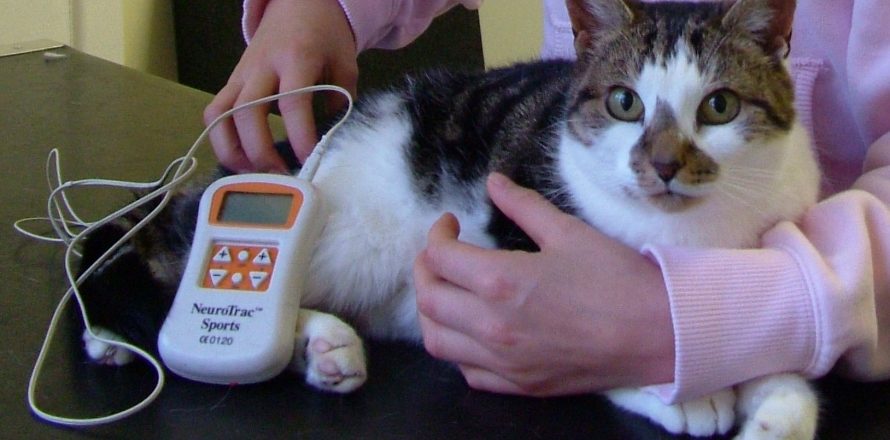Sophie is a home-loving cat, and when there was no sign of her for three days, her family knew that there was something very wrong. They searched everywhere for her, and had almost given up hope. Then one morning, she appeared at the back door. She was very hungry, and she was delighted to be back, but she was unable to stand on her hind legs. She was brought in to see me at once.
When I examined her, she seemed weakened and traumatised, but in good health generally, with no life threatening injuries. However, it was obvious that she had suffered a crushing-type injury to her pelvic area. I could feel that the bones of her pelvis were out of the normal alignment. I admitted her for the day so that we could take x-ray pictures of her spine, pelvis and back legs. The x-rays revealed what had happened. There were multiple fractures of the bones of her pelvis, which is the large bone that links the spine to the back legs. The normal rectangular box shape of the pelvis had been squashed, and it was now shaped like a half-collapsed house of cards. Luckily, the most critical parts of the pelvis had not been damaged. The connection between the pelvis and the spine was unharmed, and both of her hip joints were intact. I knew from looking at the fractures that Sophie would be able to walk again, but there were some risks along the way, and her recovery was going to take several months.
Sophie was sent home with pain relief and instructions for strict rest, and I saw her again three days later. By then, she had recovered from the trauma of being away from home for a week, and she was stronger and in better form. I allowed her to walk around the consulting room, so that I could watch how she was using her hind legs. She was doing well, and she was able to make her own way across the room. Her right back leg was almost normal, but her left back leg was very floppy. She was just dragging it behind her. When I examined this leg carefully, it was obvious that it was much weaker than it should be, with reduced reflexes and no strength at all. There had clearly been some damage to the nerve supplying her left hind leg, and this was causing a weakness that was exacerbating her pelvic injuries. I decided to refer Sophie to a physiotherapist so that a full rehabilitation programme could be planned for her.
Physiotherapy in animals is a relatively new profession. A vet’s daily work involves a very wide range of different aspects of the diagnosis and treatment of animals. Veterinary surgeons receive intensive training in the assessment and treatment of injuries, but they do not specialise in physiotherapy any more than human doctors.
Physiotherapy has been used for many years in humans, but it is only recently that its value to animals has begun to be fully recognised. Many conditions involving muscles and bones can be effectively treated with physiotherapy, including arthritis in older dogs and weakness of the back legs. It is also used to assist recovery following orthopaedic operations or spinal surgery. Sophie, recovering from a road accident, was an ideal candidate for physiotherapy.
Veterinary physiotherapy has developed as a direct extension to the human profession. Physiotherapists who have been trained to work with humans have gone on to do further studies in the application of their skills to animals. A number of Irish chartered physiotherapists have carried out a Masters degree course in veterinary physiotherapy at the Royal Veterinary College (RVC) in London. This two-year, part time course for chartered physiotherapists involves college attendance for one weekend a month, the completion of a research project and practical experience with a qualified animal physiotherapist. Animal physiotherapists always work alongside veterinary surgeons. If a vet feels that a case would benefit from physiotherapy, an arrangement is made to refer the patient to the physiotherapist, and from that point onwards, the animal’s care is shared between the vet and the physiotherapist, with each updating the other on progress and changes in treatments.
I referred Sophie to Kate Plowman, a physiotherapist who works with horses and pets in the Leinster area. Kate carries out regular sessions in veterinary practices, working on cases where the vets feel that she will be able to assist. She uses a combination of physical exercises together with some specialised treatments such as ultrasound and laser therapy. Kate carried out a full assessment of Sophie’s mobility problems, and the main issue seems to be atrophy of the muscles of her left hind leg associated with the nerve damage.
She recommended a course of electrical muscle stimulation, using a compact piece of equipment designed for this purpose which Kate loaned to the Magee family. Sophie had fur clipped in several places around her pelvic area, and she does not seem to mind when electrodes are attached and a small current of electricity is switched on. This has to be done once daily for three weeks, when Kate will carry out a review of her progress.
Sophie is an easy going cat, who purrs as she receives her physiotherapy. The rule of “no pain no gain” certainly does not apply to this patient.
TIPS
- Pelvic injuries are a common consequence of road accidents in cats
- Traditional veterinary treatment involves rest and pain relief
- Physiotherapy offers an additional way of rehabilitating cats with this type of injury

